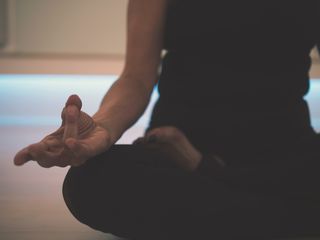Stress
Yoga in the Time of Coronavirus
Yoga can help reduce stress while staying at home.
Posted April 6, 2020 Reviewed by Jessica Schrader
I am pleased to welcome Danielle Rousseau, Ph.D., LMHC, as my guest blogger for this post on yoga. Rousseau is an expert in the science behind yoga and how yoga can help people get through adversities. Today, she writes about using yoga to help cope with the stress around the coronavirus pandemic.
Uncertainty, lack of control, and lack of information—these are primary triggers of stress. Due to the coronavirus, we find ourselves in a time of uncertainty, with little information (or too much information with no real way to discern what is “real”), while often feeling out of control. In addition, social distancing leads to isolation, loss of our daily routines, and less access to some coping strategies. In the time of coronavirus, what can we do to manage stress?

Yoga is one stress management tool that we can do from our homes. Unlike some activities, you can practice yoga in a small space with little to no equipment. You can practice on your own, or with guidance. There are many free yoga videos on YouTube and elsewhere for guided yoga practices of all types. In a heartening response to social distancing requirements, many yoga teachers and organizations are offering resources for both live and recorded yoga sessions. Recorded sessions can be practiced at whatever time works best for you. Virtual live sessions also allow the potential for connection with others, a valuable offering in this time of isolation.
So why yoga?
Well, simply, because it works. More and more empirical evidence supports yoga as an adjunctive strategy for managing stress and increasing wellbeing. People who practice yoga experience less anxiety, less depression, and fewer symptoms of post-traumatic stress disorder. Yoga also improves wellbeing, including increased gratitude, compassion, relatedness, acceptance, centeredness, empowerment, self-esteem, compassion, self-awareness, and hope.
In a study I recently conducted with the non-profit Yoga 4 Change, yoga students who participated in a trauma-informed yoga curriculum while incarcerated reported many positive effects. They experienced better emotional regulation, self-compassion, forgiveness, and posttraumatic growth. Participants slept better. They also experienced less anxiety, implemented more positive coping strategies, and shared their coping tools with peers and family members.

Yoga can help us to manage stress and self-regulate, an important tool in the current time. We are all equipped with innate coping strategies for responding to stress—but sometimes our stress response can become out of balance. We are living in a world that regularly activates our sympathetic response—the body’s way of responding to stress, sometimes called “fight or flight.” This is balanced by our parasympathetic response, the way our body helps us rest and relax. Yoga can help bring our parasympathetic response back online and allow us to find balance. Activating our parasympathetic response brings us into a more restful space and allows us to find calmness, connection, and compassion. The deep mindful breathing of yoga and meditation stimulates the vagus nerve, which activates the parasympathetic nervous system and supports self-regulation and stress management.
Yoga can help us self-regulate during times of stress in two ways, top-down and bottom-up, altering messages from our brain to our body and our body to our brain. This happens through movement, our breath, and the practice of mindfulness. A bottom-up approach alters the threat detection system and autonomic nervous system functioning (sympathetic and parasympathetic responses) and a top-down approach modulates messages from the prefrontal cortex, the executive functioning part of our brain that helps us to with critical thinking, memory, and self-control
Guidelines for Clinicians When Recommending Yoga
Yoga can be a valuable tool for self-care, especially in challenging times. Yoga is now being used as an empirically based treatment, often in combination with other interventions, with benefits for both physical and mental health. Many clinicians are recommending yoga as it may help support the effectiveness of traditional treatment approaches.
It is important to note that not all yoga is the same, and clinicians must be mindful in making referrals. In a recent article, "#MeToo and Yoga: Guidance for Clinician's Referring to Trauma-Informed Yoga," my colleagues and I recommend guidelines for therapists. Referral to yoga should be intentional and informed and recommended practices should be trauma-informed.
Trauma-informed yoga refers to practices that integrate an awareness of and responsiveness to the many potential impacts of the trauma response. This is particularly important for survivors of sexual trauma, as some aspects of traditional yoga classes, like physical adjustments by instructors, may induce a trauma response. Trauma-informed yoga is a category of instruction that specifically and intentionally considers the impact of trauma and recognizes the ways that yoga itself has the potential to traumatize and even retraumatize. Yoga that is trauma-informed prioritizes the needs of participants, creating an environment that is as safe as possible.
“Trauma-informed yoga is a discipline of nuanced seeing and heightened understanding of how each yoga participant is experiencing the practice at any given moment, in any circumstance. It considers the safest possible experience of yoga to be the surest path for each person to become a stronger, more alert, and discerning individual.” –Rousseau, Lilly, and Harris, 2018
Yoga is an easily accessible tool for any body type or physical ability. It can be restful and restorative or physically active, depending on physical ability or needs. Despite many glamorized images of yoga in the West, yoga can be an affordable tool for self-care. Anyone can access yoga via books or free online videos.
In our current time of social and physical distancing, many teachers are offering online content that is free or by donation. While it is wonderful that there is free and accessible content available, also remember that many yoga teachers have just lost their primary livelihood. If you do have the means, please consider paying for online content when possible. While adjustment to the tech of virtual classes can be a challenge, online yoga can be a wonderful opportunity to take a class with a favorite teacher that is not local or even try a class in a different country. Additionally, people who struggle with body image can practice without fear of judgment.
There is no denying or minimizing how challenging the current times are. It is OK to be unsure of what to do. It is OK to feel anxious, overwhelmed, or sad. It is also OK to take comfort in tools, both familiar and new, to support our individual and collective wellbeing. When we actively choose a tool of self-care, we better equip ourselves to survive and seek resilience in difficult circumstances. While it is but one tool, yoga offers the potential for connection and well-being, even in these challenging times.
© 2020 Danielle Rousseau. All rights reserved.
Further reading: Also see the post for people who may be locked down with someone violent during the coronavirus pandemic.
Danielle Rousseau, Ph.D. LMCH, is a professor, researcher, clinical therapist, and certified yoga teacher. Her upcoming book, Yoga and Resilience: Empowering Practices for Survivors of Sexual Trauma, is due out this spring.
Sherry Hamby, Ph.D., is a research professor of psychology at the University of the South and the Director of the Life Paths Research Center.
References
Cramer, H., Lauche, R., Langhorst, J., & Dobos, G. (2013). Yoga for depression: A systematic review and meta-analysis. Depression and Anxiety, 30(11), 1068-1083.
Rhodes, A., Spinazzola, J., & Kolk, B. V. D. (2016). Yoga for adult women with chronic PTSD: A long-term follow-up study. The Journal of Alternative and Complementary Medicine, 22(3), 189–196. doi: 10.1089/acm.2014.0407
Smith, C., Hancock, H., Blake-Mortimer, J., & Eckert, K. (2007). A randomized comparative trial of yoga and relaxation to reduce stress and anxiety. Complementary Therapies in Medicine, 15(2), 77-83.




